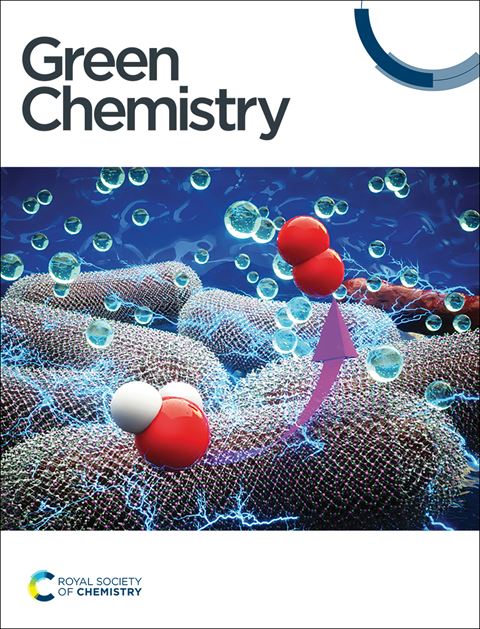实现生物精炼的生物化学:从生物油中提取多酚作为生物柴油抗氧化剂的案例研究†
IF 9.2
1区 化学
Q1 CHEMISTRY, MULTIDISCIPLINARY
引用次数: 0
摘要
虽然生物质热解产生的生物油可以加氢处理或裂解为运输燃料,但经济和能源挑战仍然存在。一种策略是热电联产在生物精炼中具有高价值的含氧生化物质。在此,我们开发了一种简单的分离方法,将蒸馏和化学萃取相结合,产生混合酚类化合物流,并探索了其作为可持续生物柴油抗氧化剂的潜力。研究表明,较高的蒸馏温度(250℃)有助于甲氧基酚、二元酚和三元酚的富集。在酚羟基的邻位和对位上存在吸电子基团可以增强抗氧化活性。酚羟基数量的增加也显著提高了抗氧化性能。某些含有最大量邻苯三酚和二元酚的提取物具有与商业抗氧化剂相当的抗氧化性能。乙酸、环戊酮、糠醛和苯醚对抗氧化活性有一定的负影响。在此基础上,提出了热解生物油分级利用策略,并对其经济可行性进行了综合评价。该生物柴油抗氧化剂的最低销售价格为1072.98美元/吨,明显低于商业抗氧化剂的市场价格,表明了该策略的经济潜力。本文章由计算机程序翻译,如有差异,请以英文原文为准。

Biochemicals to enable biorefining: a case study of polyphenol extraction from bio-oil for utilization as a biodiesel antioxidant†
Although bio-oil from biomass pyrolysis can be hydrotreated or cracked into transportation fuel, economic and energy challenges remain. One strategy is the cogeneration of oxygen-containing biochemicals with high value in biorefining. Here, we developed a simple separation method a with combination of distillation and chemical extraction to produce a stream of mixed phenolic compounds, the potential of which as a sustainable biodiesel antioxidant was explored. The study revealed that higher distillation temperatures (>250 °C) contributed to the enrichment of methoxyphenols, binary phenols and ternary phenols. The presence of electron-withdrawing groups at the ortho and para positions to phenolic hydroxyl groups was found to enhance antioxidant activity. An increase in the number of phenolic hydroxyl groups also significantly improved antioxidant performance. Certain extracts with the maximum amount of pyrogallol and binary phenols exhibited comparable antioxidation performance to commercial antioxidants. Acetic acid, cyclopentanone, furfural, and benzyl ether exhibited a certain negative effect on antioxidant activity. Based on these findings, a graded utilization strategy for pyrolysis bio-oil was developed, and the economic feasibility was comprehensively evaluated. The minimum sales price of the biodiesel antioxidant was calculated to be $1072.98 per ton, which is significantly lower than the market price of commercial antioxidants, indicating the economic potential of this strategy.
求助全文
通过发布文献求助,成功后即可免费获取论文全文。
去求助
来源期刊

Green Chemistry
化学-化学综合
CiteScore
16.10
自引率
7.10%
发文量
677
审稿时长
1.4 months
期刊介绍:
Green Chemistry is a journal that provides a unique forum for the publication of innovative research on the development of alternative green and sustainable technologies. The scope of Green Chemistry is based on the definition proposed by Anastas and Warner (Green Chemistry: Theory and Practice, P T Anastas and J C Warner, Oxford University Press, Oxford, 1998), which defines green chemistry as the utilisation of a set of principles that reduces or eliminates the use or generation of hazardous substances in the design, manufacture and application of chemical products. Green Chemistry aims to reduce the environmental impact of the chemical enterprise by developing a technology base that is inherently non-toxic to living things and the environment. The journal welcomes submissions on all aspects of research relating to this endeavor and publishes original and significant cutting-edge research that is likely to be of wide general appeal. For a work to be published, it must present a significant advance in green chemistry, including a comparison with existing methods and a demonstration of advantages over those methods.
 求助内容:
求助内容: 应助结果提醒方式:
应助结果提醒方式:


